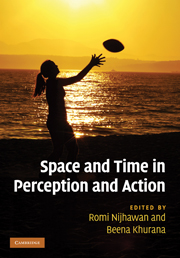Book contents
- Frontmatter
- Contents
- List of contributors
- Acknowledgments
- 1 Space and time: the fabric of thought and reality
- Part I Time–space during action: perisaccadic mislocalization and reaching
- 2 The internal eye position signal, psychophysics, and neurobiology
- 3 Factors influencing perisaccadic visual mislocalization
- 4 Visual and nonvisual factors in perisaccadic compression of space
- 5 Keeping vision stable: rapid updating of spatiotopic receptive fields may cause relativistic-like effects
- 6 Combined influences of extraretinal signals, retinal signals, and visual induction on space perception and manual behavior in perisaccadic and steady viewing
- 7 Space constancy: the rise and fall of perceptual compensation
- 8 Intercepting moving objects: do eye movements matter?
- 9 The utility of visual motion for goal-directed reaching
- Part II Temporal phenomena: perception
- Part III Temporal phenomena: binding and asynchrony
- Part IV Spatial phenomena: forward shift effects
- Part V Space–time and awareness
- Index
- References
2 - The internal eye position signal, psychophysics, and neurobiology
from Part I - Time–space during action: perisaccadic mislocalization and reaching
Published online by Cambridge University Press: 05 October 2010
- Frontmatter
- Contents
- List of contributors
- Acknowledgments
- 1 Space and time: the fabric of thought and reality
- Part I Time–space during action: perisaccadic mislocalization and reaching
- 2 The internal eye position signal, psychophysics, and neurobiology
- 3 Factors influencing perisaccadic visual mislocalization
- 4 Visual and nonvisual factors in perisaccadic compression of space
- 5 Keeping vision stable: rapid updating of spatiotopic receptive fields may cause relativistic-like effects
- 6 Combined influences of extraretinal signals, retinal signals, and visual induction on space perception and manual behavior in perisaccadic and steady viewing
- 7 Space constancy: the rise and fall of perceptual compensation
- 8 Intercepting moving objects: do eye movements matter?
- 9 The utility of visual motion for goal-directed reaching
- Part II Temporal phenomena: perception
- Part III Temporal phenomena: binding and asynchrony
- Part IV Spatial phenomena: forward shift effects
- Part V Space–time and awareness
- Index
- References
Summary
Summary
“Real-time sensorimotor control requires the sampling and manipulation not only of parameters representing space but also of those representing time. In particular, when the system itself has inherent processing delays, it invites a situation in which sampled parameters from a peripheral sensor may no longer be valid at the time they are to be used, due to the change in state that took place during the processing delay” (Dominey et al. 1997). In this chapter, we focus on the situation in which a visual stimulus is flashed near the time of a saccade, and the subject's task is to orient the eyes toward the site where the stimulus has been. To perform this task in complete darkness, the subject's brain has to rely on only two signals: retinal error signal and internal eye position signal (iEPS). This is one of the most interesting situations in which the brain has to compute something in the face of specific physical odds (e.g., very long latencies), and we have some hints on how it proceeds. We analyze the time course of the iEPS – which appears quite distorted – using electrical stimulation of brain structures, instead of natural visual stimuli, to provide the goal to be localized. Different hypotheses are then discussed regarding the possible source and possible neural correlate of the iEPS.
Although vision is usually thought of as a continuous process – continuous in space and time – it is periodically interrupted by rapid eye movements called saccades.
- Type
- Chapter
- Information
- Space and Time in Perception and Action , pp. 9 - 18Publisher: Cambridge University PressPrint publication year: 2010



